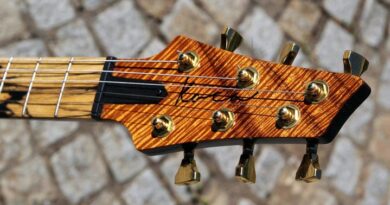Q&A: Jörg Tandler of Tandler Guitars
Jörg Tandler interview by Guest Contributor.
Hi Jörg. I think that I’ll begin with a typical question; the one about yourself. You are pretty well known especially in Europe but we don’t have any information who really you are. Can you please tell me how did it all happen, how you involved with music, guitar, strats, guitar making etc.
Jörg Tandler: Hello and thanks – I try to make a long story short! I grew up in former Western Germany and always was in love with the sweet sound of overdriven guitars that I could listen to on AFN radio or even on “Beat Club” in German TV. By the age of 14 I started to play the guitar trying to figure out Hendrix, Blackmore and Page licks from listening to records with my sisters cheap Hofner Nylon, which soundwise was of course not really satisfying.
During school holidays I earned some money at my uncles carpenters shop and bought my first amp, a ´69 Fender Bandmaster Reverb Amp and borrowed an unplayable department store electric from my cousin – this only helped a little. By 1980 I got my first serious and affordable solidbody, an Ibanez Roadster (Strat style) which later served as main pimping object for all kinds of projects like pickup swapping, fret leveling, refretting, electronics mods and so on, as I was never really satisfied with its sounds.
By that time I played in several bands in town and Rock´n´Roll of all kinds was a big thing over here. While still in school I obtained an Olympic White Strat body from the Framus bankruptcy. Bought a blank Maple neck from a German tonewood dealer and built my first Strat from that – Van Halen style of course. Also involved a great deal in woodworking as a kid the job of a luthier actually seemed much more appealing to me than going to University. So after school and serving my country at the Red Cross I applied for a job training as an apprentice at the Hoyer guitar factory, premier maker of fine solidbody guitars in Erlangen/Germany at the time and finally got the job.
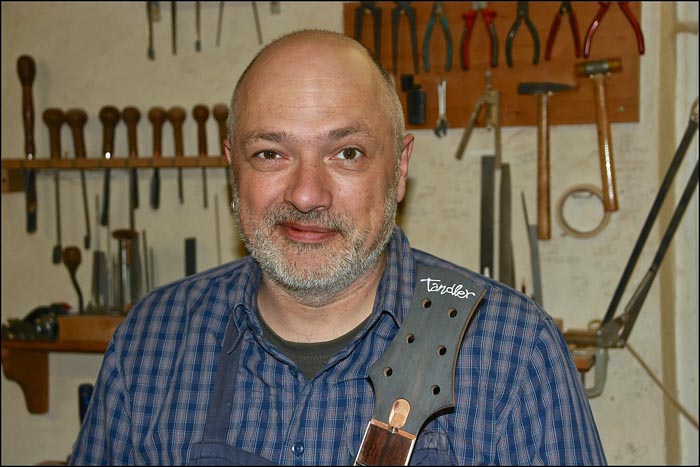
My masters were Walter Krahl for the solidbodys and archtops and Hans Herb for classical Nylon stringed guitars – you can imagine what a great experience it was to learn from the old masters! By the end of 1987 the owner unfortunately closed down the factory. And I then found a new job at Schack Guitars/Germany which was a fresh young master specialized in building carbon fiber bass guitars besides all the standard stuff. After a good 5 years helping that company grow I decided to join with Helmut Hanika Guitars building classical Nylons only for 1,5 years before I got self employed and founded Morgaine Guitars in 1994 and attended the 1995 Frankfurt intl. Music Fair for the first time. In 2005 I decided on typing my very own name on the headstocks and totally quit serial production in favour of custom making each single guitar traditionally luthier style.
Can you please introduce your own guitar models. Since there isn’t much information on your official website, I believe most of people will like to know. The models, specifications, advantages sides to your competetors etc.?
Jörg Tandler: Well, first of all I do still not run a website and what one can see on the internet might be some guitar brokers sites.
As we all know well and can listen to on a million records is the Stratocaster and the Les Paul Standard which had become THE classical solidbody electrics, but the designs of the 1950ies as well as the quality of their factory making needed an overhaul, proven by guitarists demands in luthiers repair departments all over the world.
Also the only modern guitars available in the early 1990ies were Metal axes equipped with Floyd Rose vibratos. This lead me to design the Morgaine Mintage (Strat) series with a certain kind of vintage feel to it but a modern and up to date approach: reintroduction of fat necks, switchable anti hum dummy coil circuit in the early ones, original but not harsh sounding pickups, handmade wooden parts, fully functional vintage style vibrato (US made Wilkinsons on the early ones), lightweight tuning machines with staggered shafts, compound radiused fretboards, modern fretwires, oil and wax finish on the necks for a broken in feel, traditional 1950ies Cellullose finished bodies. Models available are the ´54 Swamp Ash/Maple neck, the ´57 Red Alder/Maple neck and the `61 Red Alder/Maple neck w. Rosewood board.
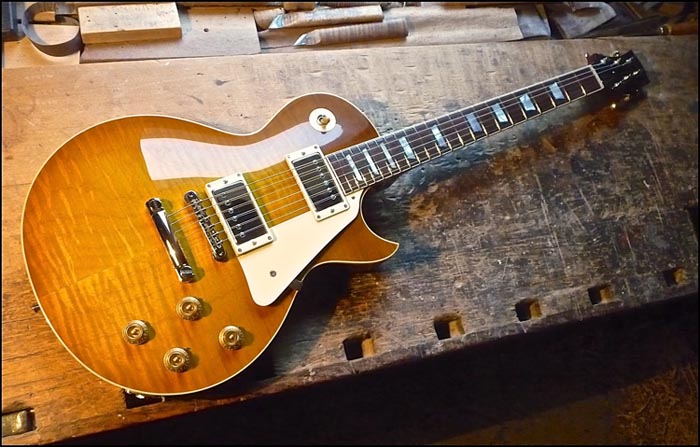
My L.P. overhaul since 1994 is called Beauty and has most of all original 1950ies tones in mind – small headstock design with almost linear running strings for better tuning stability, less headstock breakability/overhauled trussrod design, headstock scroll, overhauled scale for better tuning, original 1950ies “Hot Laquer” finish with original mineral fillers, original 1950ies top carve/handmade, compound radiused fretboard, best hardware and electronics for the above mentioned matter.
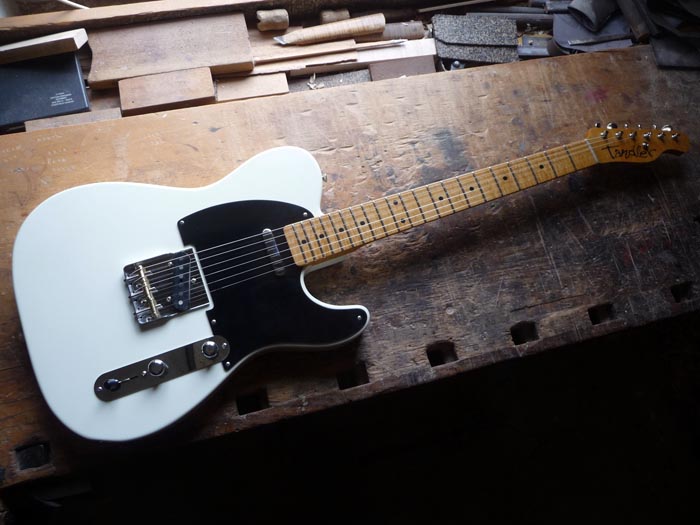
The Chopper guitar is my take of an early Telecaster, also spiced up and build according to the customers demand, available since 1998. Also introduced in 1998 is my original Austin Rocker guitar which features an offset design, 63cm scale length – a marriage somehow between a Tele and a Firebird guitar made fully of Mahogani, set neck, wraparound or Tunomatic bridge, bridge PAF/Tele neck pickups or P-90ies, reversed headstock wt. Kluson style tuners.
Another original in the line is my Desperado guitar, a single cutaway offset design with a larger body for increased bass response, available in Strat as well as Tele mode. The Mescalero guitar features the outline of the Desperado but is a full Mahogani set neck humbucking guitar, Strat scale length, Tunomatic bridge, which is a cool well balanced sounding guitar not only for dropped tunings. Further we’ve got my Krahl model named after my old Master. In general it’s a Les Paul wrapped in a Stratocaster outfit which we already built in the 80ies at the Hoyer factory – full Mahogani, arched Maple top, bindings, set neck, wraparound or Tunomatic bridge, one or two humbuckers.
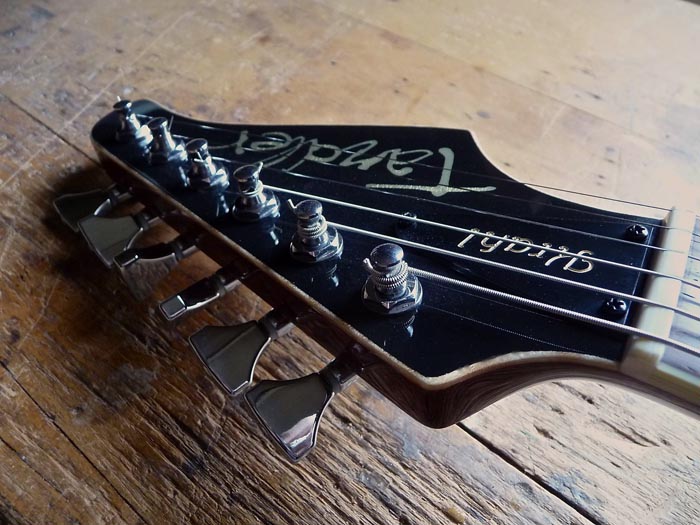
The latest entry to the program are my Grandmaster acoustic steelstrings, Grand Concert sized in a wide variety of woods as well as construction options. All feature a 635mm scale with smooth and easy playability in mind. Top model of the line is a Nomex (Kevlar Honeycomb) laminated Double Top version. Since a couple of years all the above mentioned guitars feature Carbon fiber reinforced and scooped out necks which greatly improves sustain. Besides those models I still build totally custom ordered guitars if the job seems to be of some interest for myself and as a luthier service is my command. There were always ES-guitars, archtops, Spanish guitars and even historical lutes on the to-do list in the past.

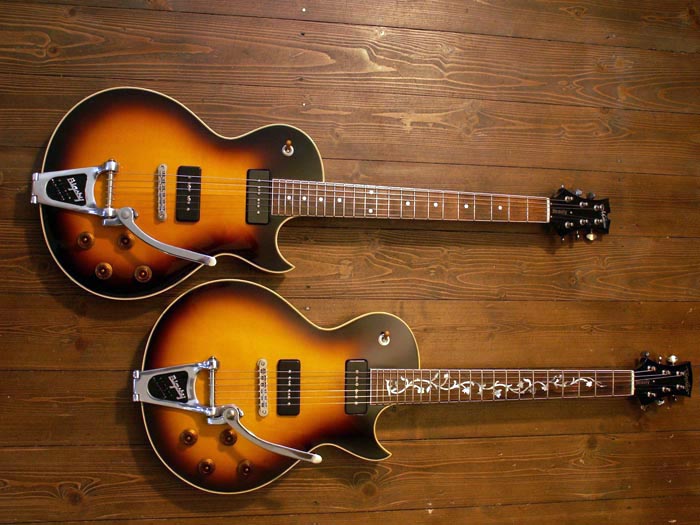
You are known for your excellent S-Type and T-Type type of guitars. But for a couple of years we are, also, aware of your impressive Les Paul type of guitars. Was it a natural part of of guitar making journey or as a result of market demand?
Jörg Tandler: That came naturally – my first serious repair job as an apprentice at Hoyer’s was a broken headstock of a 1954 Black Beauty Les Paul Custom together with the laquer touchup. Since the early 1970ies people were bemoaning the loss of tone and feel of those 50ies vintage beauties on the actual available guitars and so quite a couple of companies like Dean Guitars, Hamer, Hoyer and others already built Gibson style high quality guitars in the 80ies.
My own work simply came out of that tradition and I make my Beauties since 1994. They probably did not get the public attention from the start as the Mintage models did, but I already had gained quite a lot experience in building or restoring such guitars. What helped in selling some Beauties was the fact that my US distributor Salwender Intl. did a great job at the time and brought me in contact with artists like Neal Schon of the band Journey for example. Another not known fact is that I built quite a couple of Beauties for a Japanese guitar store before the word spread over here.
Can you please give us information of building process of Morgaine Guitars? Do you do all of the jobs yourself or have someone to help you?
Jörg Tandler: When I was still building under the Morgaine labelI was working with an apprentice and a carpenter in my shop. We did most of the things by hand just like they did in the 1950ies plus using traditional power tools. We built an average of about 50 guitars annually, without outsourcing anything and sold about 90% of them via a small dealer/guitarshop network. We always made small batches of 5 guitars simultanously. Since 2003 I’m working all by myself again and as a result of an ongrowing demand for custom made guitars do only one at a time, traditional luthier style with even more handwork than before. Since 2005 they are therefore labelled Tandler.
How long does it take to build a Tandler Guitar from the chunk wood to final product?
Jörg Tandler: That takes about a month, mainly because of drying times – when I do finishing work on one guitar, I do woodworks on another. Waiting time from the order to final shipping is of course another story…
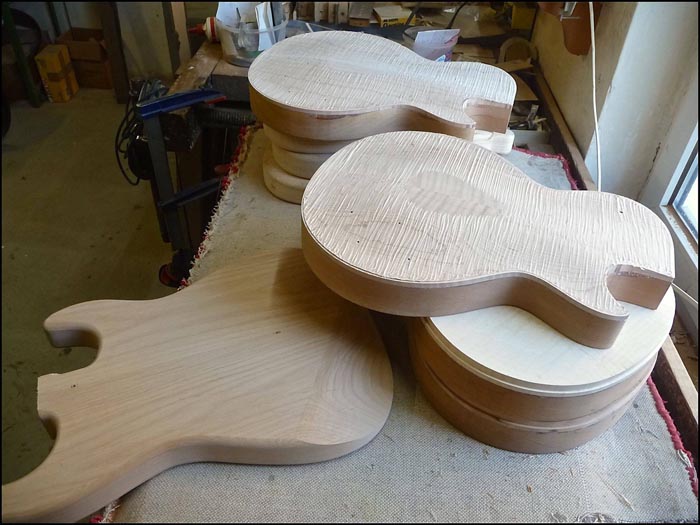
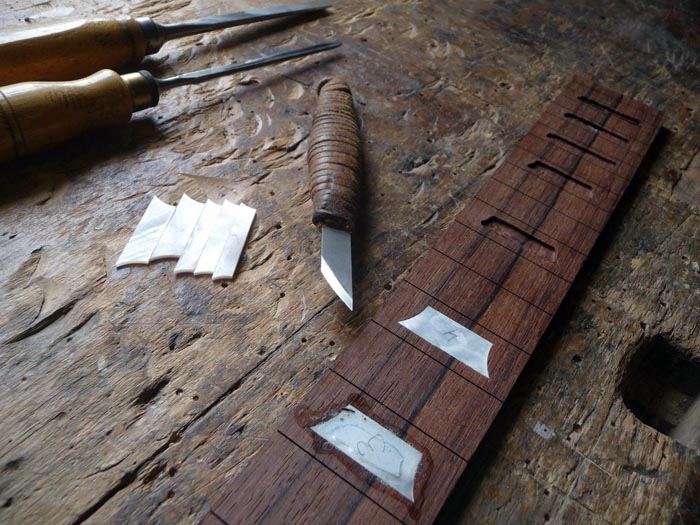
What are the sources of your woods. What origin of woods do you prefer for bodies, necks, fretboards?
Jörg Tandler: Buying woods for the making of top of the line instruments is a task of its own and that keeps me busy since day one! I was collecting wood since my days at Hoyer as an apprentice (and still stock some Arnold Hoyer Rosewood!). At Schack guitars we cut tonewoods in a larger scale for companies like Lakewood, Taylor, Gibson and others and here I also bought some from my boss. Of course you regularly buy some from sawmills and wood importers as well. Sometimes there had been occasions at company closedowns etc. – I got on to some Cello woods from the 1960ies for example for making archtops when the widow of a double bass builder sold the shop.
For my solidbody guitars I have to rely on imported wood species mainly. To really sound like Billy Carson you need US Red Alder, or Swamp Ash, as those two do not grow over here. For the necks of those you need Rock Maple. The real deal for LP-style guitars is still “Honduran” Mahogany. I can sight and still buy all of them in Germany. I am not a great fan of CITES regulations so I sorted out the Brazilian Rosewood for the fretboards long ago. I did a lot of research and experiments on substitutes on other Rosewoods for that matter and found a pretty good one in Madagaskar Rosewood which is only listed CITES II nowadays.
You are well-known with your S-Type guitars exclusively. Many people prefer your guitars instead of buying a Custom Shop level Fenders or any other boutique builders something. What’s your secret about making great guitars or making guitar great. Let’s make it more spesific, what’s your recipe for a perfect S-Type guitar?
Jörg Tandler: Especially in the solidbody guitar business a most often overlooked key fact to make a great guitar is actually understanding wood. The solidbody started out as an industry mass produced product and nowadays precise CNC milling helps in this respect further. To make a really outstanding sounding Strat let’s define some of its wanted characteristics first. a) you want a superfast attack b) you want as much sustain as possible c) you want even loudness throughout all strings (good balance) d) you do not want deadspots e) you want great dynamic response.
These five points are all neutral parameters and tell nothing about the overall frequency based timbre of the guitar and I like to leave this out for the moment, just because of a zillion different personal tastes. As wood is a natural material and every single tree did grow under different circumstances, it has to be treated in special ways. As a luthier I have to rely on woods which are stocked for a long, long time versus industrial “just in time” production.
Experience shows that artificial drying cannot be compared to stocking it under “breathable” conditions for several seasons before using it in the shop. It will be then most likely be free of inner stress which naturally occurs in every piece of wood during the drying process plus it does not warp that much under unfavourable climatic conditions than the chamber dried ones do. Picking a hopefully stressfree piece of wood for all guitar parts is the first thing, but in the course of the making one could put unwanted stress in the material as well, which counteracts free vibrating strings. There are several steps in the making which therefore should be carried out by handtools (handplane e.g.) only and I might come to that later.
When it comes to nailing the right timbre of a guitar for a certain customers needs I simply rely on the experience I made with my stash, so buying just single wooden blanks from unknown origin does not help. I favour to buy a whole tree, let it sit for about 10 years, build a single body or neck from it and then know how it sounds. It’s that simple. Choosing the right hardware for the customer is another challenge and I try out a lot what comes in my way. Same with pickups. A nice handcarved neck is a must as well as the deep lustre and warm handling of a thin Nitro finish and its ageing characteristics. In the end its got to have some Mojo and should also be distinguishable from other makes.
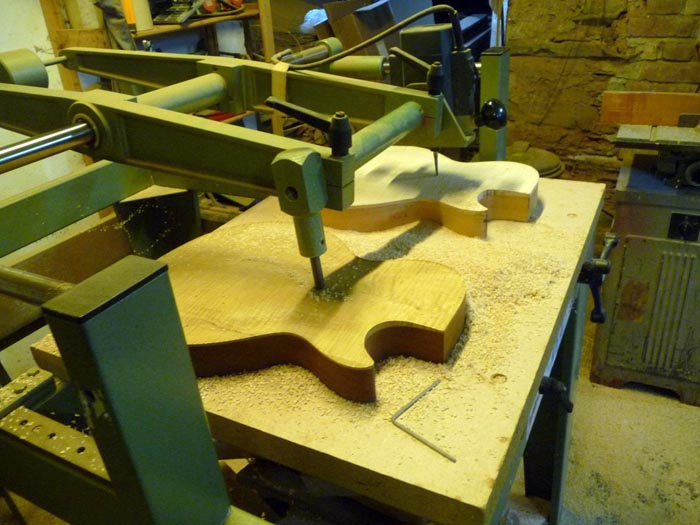
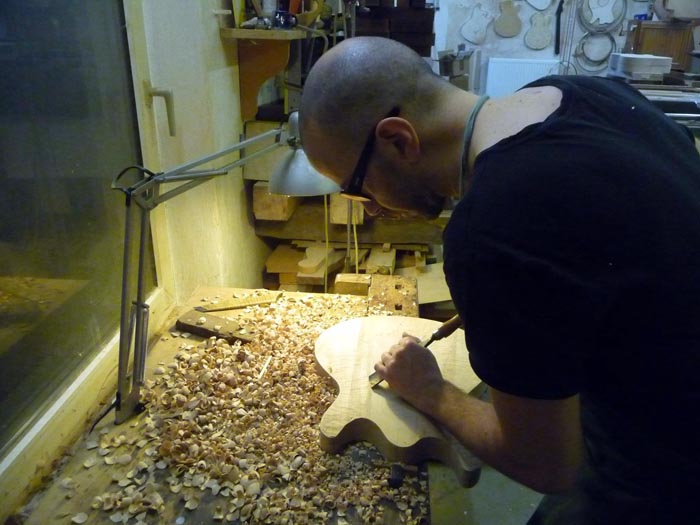
Why do you prefer two piece of alder instead of one?
Jörg Tandler: A one piece body is always more likely to warp under drastically changing climatic conditions and is more likely under natural stress than a wide piece cut in two halfes and glued together the right way. As I mentioned before I try to avoid material under stress. I also do the joints, beliefe it or not, with a handplane, because this is the only way to achieve the smoothest and flatest surface for a glue joint – I do not even need much pressure by clamping the parts together. In ordinary carpentry this procedure can lead to more than a ton (1000kg) pressure applied to the wood to get a nice invisible glue joint and that’s not very good.
Your Morgaine Mintages have a different design of forearm contour. Why do you carve like that, what’s the function of that spesific design?
Jörg Tandler: I do all the body shapings by hand and every single one differs from other bodies. Over the decades my personal (visual) preferences also changed quite a bit compared to those from the 1990ies. What I definetely do nowadays is not to carve too much off from the rear for the belly shaping, because I like to hear those extra 40 Gramms…LOL. But seriously the whole body outline of the Mintage is modified suiting my aesthetics anyway.
Let’s talk about the necks. First of all, what kind of maple you prefer mostly? What do you think about European maples and do you use them on your guitars?
Jörg Tandler: I am strictly using north American Hard Rock Maple for the real deal in tones/weight. We do have the very same Maple species over here and I used it several times when I found an adequate hard and heavy piece. The good stuff comes from upper Bavaria and it’s not the lightweight Maple species used on violins! B.t.w. this is the real deal for Les Paul tops, too! Violin Maple (acer pseudoplatanus) is very strong but lightweight and is almost white in colour, but produces much too much treble frequency wise for the tones I want to hear.
Red Maple/Soft Maple from north America is often very curly or even quilted, but much too soft and too light in weight for a neck and tonewise pushing the upper mids which could be a bit harsh sounding. I’ve seen Strats with Soft Maple necks – more trussrod tension needed on those also, what I do not want.
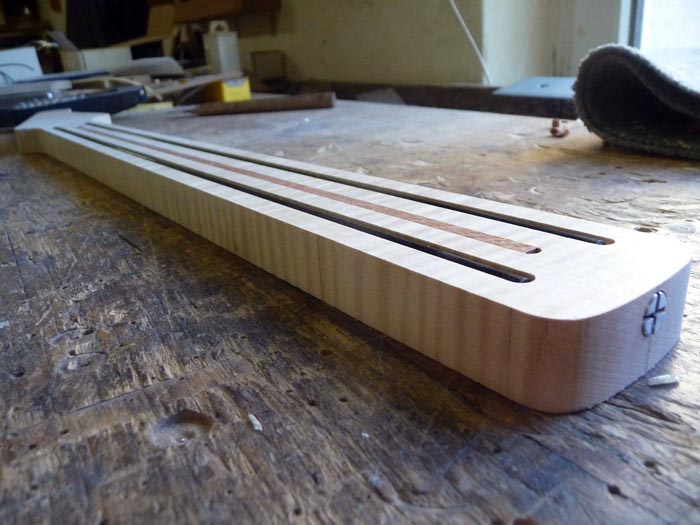
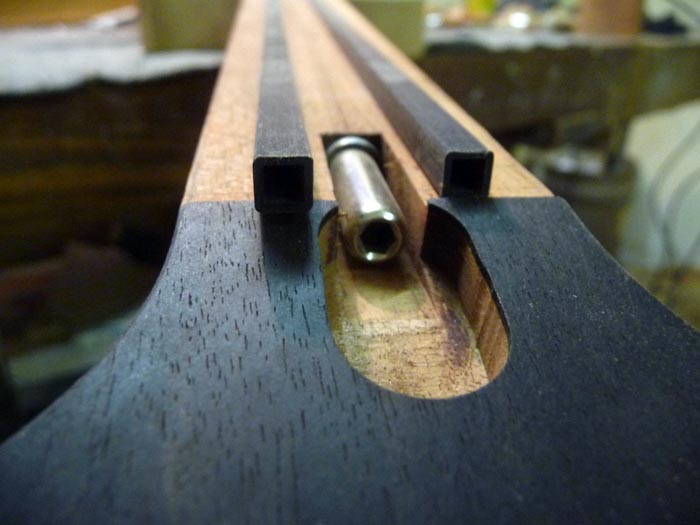
The thickness of the neck is one of the most significant aspect for the tone of the guitar I believe. I saw your guitars have very chunky necks so that i assume that we both think the same. So, what importance does the necks have on the nature of tone?
Jörg Tandler: Well, I guess I was one of the first guys in the 90ies offering chunky necks again. Not only they offer superior hand support when bending strings, but for tonal reasons also. It’s not a problem to build a thin but stable neck by hand, but added mass in that part also adds sustain and thickens up your tone! Thick/heavy necks also have a different response from the moment on you pluck a string.
It is a similar reaction like on L.P. style guitars where after plucking, the tone first grows and gets louder before it finally quietens down and dies after a certain period of time – it’s like a built in compressor pedal. But the weight ratio in between the body and the neck have to be balanced! If you put on a super heavy neck on a super lightweight body it usually ends up in an energy killing vibrating body which means deadspots and bad sustain!
How do you evaluate those three maples as neck material; plain sawn maple, quartersawn maple, flamed maple in the manner of tone. Consider all the other variants are same (same body, pickups, neck thickness, neck humidity etc.).
Jörg Tandler: Tonewise there’s not a single % difference in between totally quartersawn, rift sawn or flat sawn hardmaple necks. Also stiffness ratios do not differ much as there is almost no difference in stiffness between the brownish looking winter rings (with a higher Lignin content) and the white summer wood in Maple – remember this is not Alp Spruce! But there are actually other factors which can be visually observed in Maple affecting tonal qualities such as the number of the storage cells (Parenchym cells) – the more of them the higher the speed of sound in the actual piece of wood… and this is proven. That simply results in a faster response.
I believe you are familiar with chambering cavities on the guitar bodies. What do you think about them and do you carve that kind of chambers on your guitars?
Jörg Tandler: We should distinguish between the kind of chambering that affects tonal qualities of a guitar to a higher degree and chambering that does not or not very much, which is possible. “Understanding wood” here I am again. Depending on the wood species sound will be carried with a speed of up to 6000m/sec parallel to the fibers and with a max of only 2000m/sec cross grain, mostly much less than that in this direction. If you cut fibers across, there wont be any transfer at all. If you do not want much alteration except for weight relief you have to see to it not to cut through wood fibers at vital points! The layout for your router therefore is dependent on your guitars outline as well as of the hardware layout and design.
In the year 2000 I introduced my Advanced Chambering System to the public at the Frankfurt trade show for that matter. It’s a multi chamber system which leaves enough wood fiber connections in all directions and therefore does not alter the transfer of sound inside this medium. I offer this as an option.
More excessive chambering often results in a slower response, bad dynamics and a softer tone with bad separation on the bass strings as well as bass frequency loss in the worst cases.
What most people do not know is that their beloved 1959 original Standards have a little chamber, in most cases between the cutaway and the control chamber. It could be located on the opposite side underneath your right arm also, as a 1960 Standard on my workbench proved last year. That chamber actually adds some pleasant compression to the tone.
Wooaw, I didn’t know that. What are your thoughts and experiences with basswood, especially Tilia Americana? Many companies use it on their low budget guitars, so it is known by some as bad tonewood. On the other hand we can see Tom Anderson or Suhr uses as a body wood. Actually, for me it may be good choice for some certain needs? What do you think?
Jörg Tandler: The guitars with bodies made out of basswoods I played always sounded lifeless to me and there were actually a lot hitting my workshop over the years – that was also the lifechanging experience with my Roadster guitar as a kid. Some people nevertheless prefer it just because it does “not sound by itself”. I remember Allan Holdsworth saying Basswood was his wood of choice for his guitar as he wants to form his tone with the fingers, pickups and amp… For me it’s not a choice as I want guitars with a “voice” (that even rhymes!).
Let’s come to the pickups. I see you like to use “Fralin Vintage Hot” a lot which I like them so very much, too. I hate overwound strat singles which lack of clearity. Who are the other pickup makers that you like to use their products?
Jörg Tandler: I did use Fralin pickups for a long time exclusively on all of my guitars except for some custom orders as I really liked their more modern voice especially on my Mintage models. Some ten years ago I had to change to another manufacturer, because from one day to another their tone had changed dramatically. During that period I tried out a lot of other makers and finally ended up in Harry Haeussel exclusively making me a set of 1965 style Strat pickups which were always my favoured original vintage pickups.
I know Kloppmann pickups for a very long time and love them. I put them in on demand if the customer is willing to pay almost four grand for the Mintage. I also liked Jason Lollars “Blackface” set as well as Sheptones “Good enough for Leo” pickups. When it comes to P.A.F.’s there is only Harrys 1959 TA. (Tandler) set or again Kloppmanns 1959 for an original average 1959 vintage tone that I’m striving for on the Beauties – none else come that close, period…
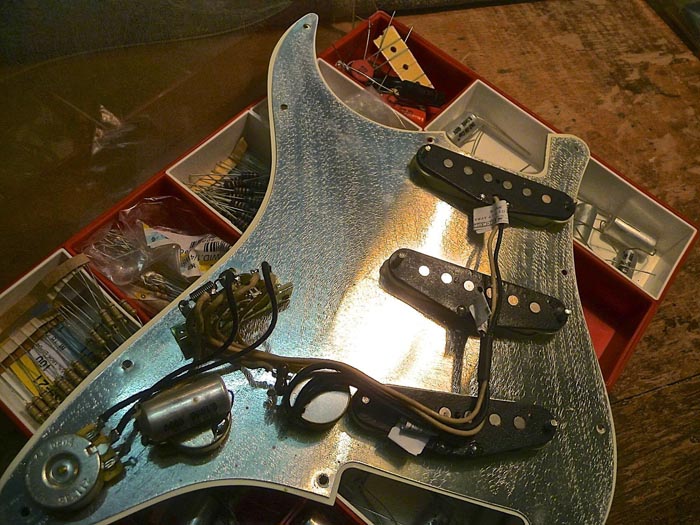
Do you have a spesific formula while choosing right pickup to right guitar? What tips can you give about how to choose right pickups for their certain guitars?
Jörg Tandler: On my guitars I’m pretty much happy with consistant voicings of the pickups as I like to hear the differences in sound coming from the wood. One can do so much difference with the amp eq or with additional stomp boxes that it does not make that much sense to me swapping pickups all the time. At least if you are happy with the general voice of the pickup. Of course one can pimp a “mushy sounding piece of wood” with a set of pickups in the lower output range with clear mids and trebles and vice versa a guitar with much too much high end with a set of overcompressed and not too clear sounding pickups.
The problem is there’s a zillion out there to choose from. My advice would be take your axe and visit the luthier next door, listen to his(her) advice if you do not want to go through trial and error by yourself!
I saw most of your S-Types have Wilkinson VSVG tremolos. Why do you use them and how about other products from another brands?
Jörg Tandler: The Wilkinson VSV was the first and only functional vintage style vibrato in the 1990ies that reintroduced a massive rolled Steel block as well as a properly hardened base plate together with unbeatable performance and so I used it for a long time until something better came along. I also used Callahams and nowadays the ABM 5050S which is best of all worlds. It offers vintage tones without the technical faults of the originals and can be treated pretty hard without a lot detuning. If authentic vintage tones are not on top of the priority list I love the Hipshot Contour whammies for their fat tone as well as their performance.
What do you think about the trem block and saddle materials? There are many thoughts around from traditional cold rolled steels to aluminium and to titanium alloys. As a note i hate zinc alloys (Zamak etc.).
Jörg Tandler: Well, all of those different materials have their influence on transfering tone from the string into the wood and therefore also peak frequencies and even increase certain peak frequencies – this can be good or bad depending on the sound of the wood underneath. My personal allround take for a Strat would ever be a properly made vintage style whammy with sheet steel saddles, steel baseplate (all of these parts properly hardened) and and a machined rolled steel block. Zinc alloys lack bass frequencies and the guitar looses balls with those as well as definition. Brass for the block can be cool if more midrange is wanted. Titanium and Aluminium also lack some bass response plus add extra presence which I do not want to hear on one of my guitars. Although those two metalls can be cool on guitars lacking definition.
Here comes the finishing question: Are you a nitrocellulose guy or open for others like acrylic paints, polyester, urethane etc.?
Jörg Tandler: In general I am open to everything as long as it makes sense for that certain project. A no go on every kind of guitar for me is old school Polyesther as it is a much too thick, too hard (almost like glass) kind of plastic overlay that even dampens the vibrations of a solidbody. There are also certain makes of UV-curing Acrylics and Urethanes on the market that act similar but not all of them. Some of them are indeed of soft types which do not kill tone on electrics as well as on acoustics but actually leave a milky plastic-like gloss which I do not like.
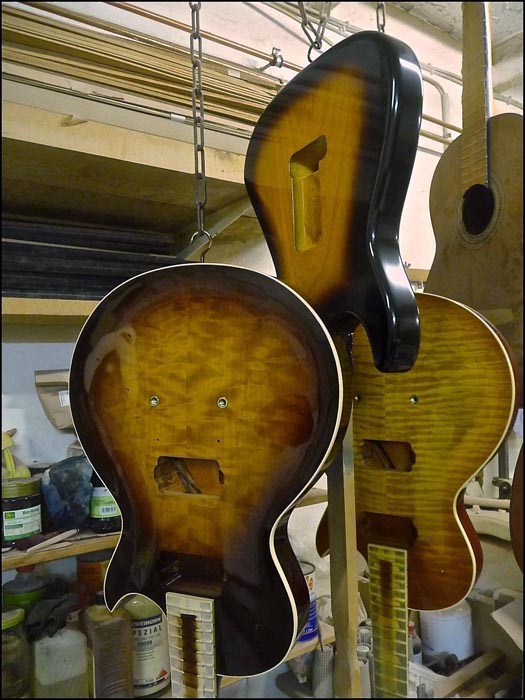
A French varnish on a steelstring or solidbody guitar does not make much sense either as it reacts to body heat, gets sticky and easily rubs off. On a steelstring Shellac even increases your treble range which could be to much – on classical guitars equipped with Nylon or Fluorocarbon strings it’s actually the best finish for the top at all! Polyurethane of a softer kind could be used with good results if applied not too thick.
I think on a higher priced electric guitar, old school Cellulose is the way to go for as it creeps deep into the wood creating a deep lustre, ages nicely and naturally, feels warm in your hands and does not alter tone in a negative way if applied too thick. It remains it elasticity for a certain period before it gets brittle and when it gets we get nice weather checks and your body still can vibrate freely. The downside is that old school Hot Laquer in all it’s glory is no longer available since the early 1990ies and modern so called Cellulose laquers contain mainly Acrylics. Those are the ones that get sticky on your necks an do not have the same lustre. I am a lucky guy, because I still stock some original Hot Laquer, the same stuff they used in the 1950ies…
Okay. Let’s talk about the roots, now. Who are your favourite guitar builders?
Jörg Tandler: There are for sure a lot of hot cats out there and one cannot know them all. Inspirational for me were Antonio Torres, Ignatio Fleta, Daniel Friedrich, DÁngelico and Jimmy Dáquisto as well as Edgar Mönch. For the still living guys it’s my ex co worker Dieter Müller who in my opinion makes the best classical guitars available, Fritz Ober, Monty from Canada, Dean Zelinsky, Ulrich Teuffel,…the list goes on.
How do you foresee the future of electric guitar? You know, the technology brings many improvements. Like auto tuning gears, carbon fiber bodies, necks made of other materials but the wood… On the other hand, there is still undeniable group of people desires vintage guitars with vintage accurate specs…
Jörg Tandler: The music for the electric guitar has been written and I do not expect really new music for this instrument – you can find electric guitar tones between Beethoven and Mozart in your favourite record store. So it has a place in history and as long as people are listening to “classical” electric guitar there will always be dedicated players enjoying the fantastic possibilities the instrument has to offer. Of course it’s not really hip for the majority of youngsters to listen to this kind of music nowadays and the market for mass produced guitars has dramatically declined since the mid 1990ies.
It will be hard times for the industry as the aftermarket is full of used instruments either. I do not think a new “supermaterial” used in the making or a new “superdesign” will save the industry neither will one create new music for electric guitar. It’s heydays definetely were the 1950ies, 60ies, 70ies, 80ies, and early 90ies and those are the sounds guitarists are striving for.
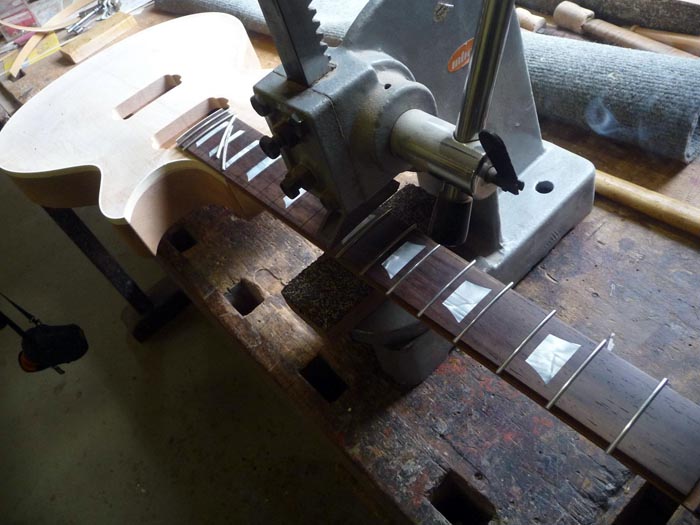

Its time for a game. I’m pretty sure you’ll get how to play. I’ll give you a word and then you will tell us shortly what does it recall firstly;
Poplar: nice tonewood
Fishing: best relaxation from work
Indian Rosewood: a very nice tonewood
Beer: not good in big volumes
German Blues Makers: often lack the groove
Turkiye: rich culture
Guthrie Govan: incredible instrumentalist
German Cars: were awesome in the 1970ies
Active Pickups: good for bass guitars
Marriage: will always be a challenge
Leo Fender: genius
Angela Merkel: grew her political life in the former GDR
Trout: too precious to kill
German Guitarists: Michael Sagmeister, Michael Schenker, Volker Kriegel, Ulli J. Roth
SRV: Tone to the bone
Endorsement: good for guitarists
Hot Girls: I love èm
Lindy Fralin: great pickup guy
African Mahogany: not on my wishlist for Christmas
Amps: one has never enough amps at home
Family: is essential to live a happy life
USA: some nice fishing destinations to visit
Football: I do not care at all
Boobs: I like them almost all
Stainless steel frets: sound shitty and kill Strings
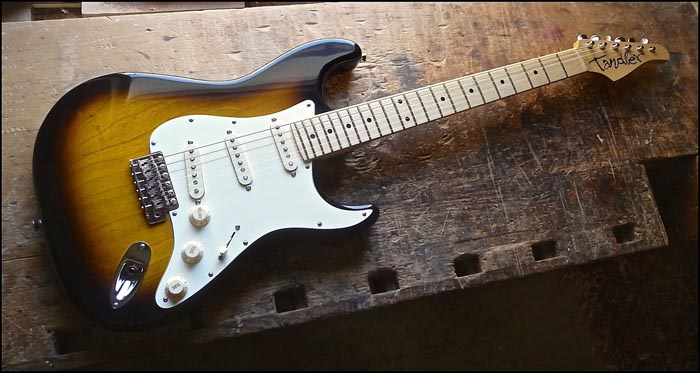
Jörg, we’ve come to the end of the questions. Hope you like it, too. Thank you so much. I request you to give a ending message to all of Darth Phineas readers & Take care 😉
Jörg Tandler: Thank you, you and your readers are welcome! I hope you enjoy as much as I did doing the interview!
Best regards from Germany!
7 string 16Ω 59 Airbucker Alnico 2 Alnico 4 Alnico 5 Alnico 8 Bare Knuckle BKP Boot Camp Brown Sound Celestion Ceramic Custom Shop David Shepherd DiMarzio Dual Resonance EVH Fishman Floyd Rose Fluence Gibson HSP90 Humbucker Ibanez JB Jimmy Page John Petrucci Les Paul MJ Mojotone P90 PAF Pariah Pickup Satch Seymour Duncan Singlecoil Single Width Speaker Steve Vai Tech Tip Tremolo Virtual Vintage


